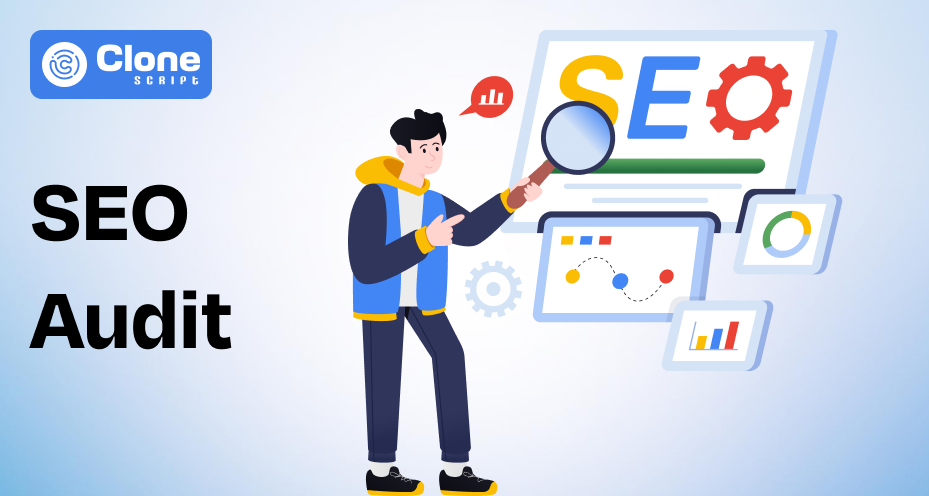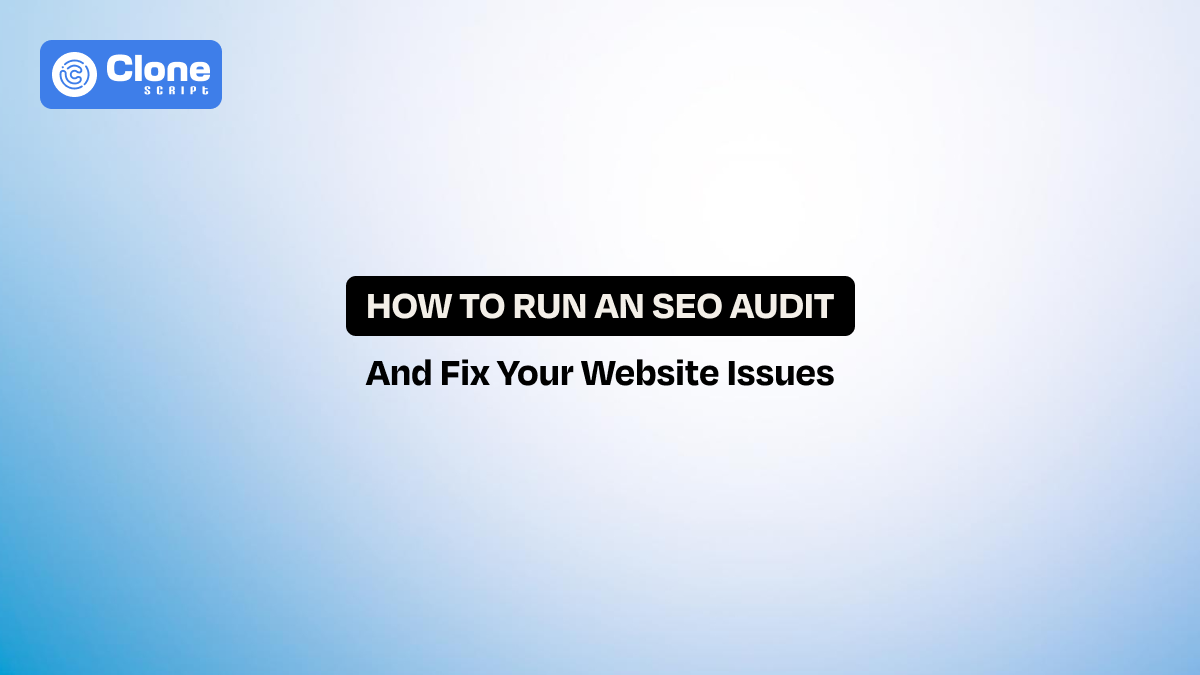How to Run an SEO Audit and Fix Your Website Issues
Did you know that 68% of online experiences start with a search engine, yet nearly 40% of business websites fail basic SEO checks like indexation, page speed, or structured data? That means almost half of websites risk losing traffic, customers, and revenue, without even realizing it.
For SEOs and digital marketers, the solution is clear: you need a comprehensive SEO evaluation. It’s not just about spotting broken links or duplicate pages anymore. In the age of AI-powered search engines, Search Generative Experience (SGE), and zero-click results, a website audit ensures your site is discoverable, crawlable, and competitive.
But here’s the catch: many “search engine optimization audit guides” out there skim the surface. They give you checklists without context. This article teaches you exactly how to run a website audit step by step to rank your site in 2025’s AI-first search world.
What is an SEO Audit?
An SEO audit, or site performance review, is a complete evaluation of a website’s ability to rank in search engines. It identifies problems that could be preventing your site from being crawled, indexed, or ranked.
Think of it as a health checkup for your website. Without one, you’re guessing why your rankings are dropping or why your content isn’t being picked up by Google’s AI-powered summaries.
4 Core Types of Website Optimization Reviews include:
-
Technical SEO audit: Checks crawlability, speed, indexation, structured data, and security.
-
On-page SEO audit: Focuses on titles, metadata, headings, keyword usage, and content relevance.
-
Content audit: Evaluates quality, topical coverage, freshness, and semantic relevance.
-
Backlink audit: Analyzes link profile, toxic links, and authority signals for search rankings.
For most websites, a technical SEO audit is the prime element. Without fixing technical issues, your content and backlinks cannot perform at their best.
Now, let’s understand why it’s important.
Why SEO Audits Are Required for Your Website?
Many business owners and SEOs ask: Why is running a technical site review useful for business websites? Let’s break it down with the realities of 2025 in mind:
1. AI-Driven Search Prioritizes Quality
With Google’s Search Generative Experience (SGE), search results are no longer just blue links. Instead, AI extracts, summarizes, and displays the most relevant content directly in the results.
That means if your site isn’t technically optimized, fast, structured, and well-linked, your content may never be chosen for these summaries, no matter how strong the writing is. A full SEO health check analyzes whether your content is discoverable and properly structured for AI-first indexing.
2. Prevents Costly Traffic Loss
SEO traffic feels free until you lose it. A small technical issue like a robots.txt error, broken sitemap, or incorrect canonical tag can cause hundreds of pages to vanish from Google’s index overnight.
Running regular site audits helps you catch and fix these problems before they silently drain rankings, organic traffic, leads, and revenue. For businesses relying heavily on search, prevention is far cheaper than recovery.
3. Protects Your Website Authority
Website authority isn’t built in a day, but it can be lost quickly. Thin content, outdated information, spammy backlinks, or crawl errors send negative signals to Google’s quality systems.
Over time, this erodes your domain trust. A site audit not only fixes errors but also safeguards your brand’s credibility, keeping your domain recognized as a trustworthy resource in your industry.
As Google introduces at least 3-4 core search updates yearly, they emphasize relevant, helpful, and latest content to help searchers find what they’re looking for.
4. Competitive Advantage
Here’s the reality: most businesses look at keyword rankings and stop there. Very few invest in full technical search engine optimization audits regularly. If you’re one of the few who do, you’ll uncover opportunities that competitors overlook, whether it’s reclaiming crawl budget, improving site speed, or fixing internal linking gaps. This gives you a competitive advantage that compounds over time, making your site harder to outrank.
5. Boosts Conversions
SEO isn’t just about rankings. It’s about business results. A faster, better-structured website keeps users engaged, reduces bounce rates, and increases conversions.
For example, improving Core Web Vitals by even a second can increase sign-ups or sales by several percentage points. An audit bridges the gap between SEO and CRO (conversion rate optimization), turning traffic into tangible business outcomes.
What are the ways to optimize a website for better search rankings in search results and AI summaries, along with visibility in ChatGPT, Geminin, and other AI chatbots?
Let’s get a detailed answer in the following section.
Step-by-Step Guide: How to Run an SEO Audit (2025 Edition)
Before you start, define success. What business metric are you protecting or growing: qualified leads, sign-ups, revenue from organic?
A great website health check isn’t just a laundry list. It’s a prioritized plan to move those numbers.
Step 0: Set the Baseline (Access, Data, Scope)
-
Access: Google Search Console (GSC), GA4, your CMS, hosting/CDN, and (ideally) server logs for 30 days.
-
Scope: List primary templates (home, hub, article, product, category), main markets/locales, and which sections matter most to the business.
-
Benchmarks: Export current clicks/impressions (GSC), top pages, top queries, and conversion pages in GA4. This gives you a “before” snapshot.
Step 1: Crawl Your Website Like a Bot
Use Screaming Frog, Sitebulb, or Ahrefs Site Audit to simulate a crawler and then a user (rendered crawl).
Configure it right
-
Run HTML crawl first, then a JavaScript-rendered crawl to catch links generated by JS.
-
Respect robots.txt, then run a second pass ignoring robots to see what you might be blocking unintentionally.
What to look for
-
4xx/5xx errors, redirect loops/chains, mixed protocol (http/https), and URL casing inconsistencies.
-
Duplicate titles/descriptions, missing H1s, parameterized URLs, pagination (rel="next/prev" legacy), and faceted navigation explosion.
-
Orphan pages (no internal links), internal nofollow, and important pages deeper than 3 clicks from the homepage.
Quick win: If 15% of pages are unreachable or trapped behind loops, you’re wasting crawl budget and authority. Fixing broken links and flattening deep paths immediately restores crawl efficiency and rankings.
Step 2: Check Indexation Status (Truth vs. Hopes)
Here is the step to know whether the web page URL is indexed and fetched by Google or not:
First, open the GSC → Put URL in the search bar and check the indexing status:
-
Compare Indexed pages vs. your XML sitemaps. Sitemaps should only contain canonical, indexable URLs.
-
Investigate “Crawled – currently not indexed” and “Discovered – currently not indexed.” These point to weak/thin content, duplication, or poor internal linking. (Translation: Google saw it, but didn’t think it deserved a slot yet.)
Reality checks
-
Use URL Inspection on a few problem URLs: Is Google choosing a different canonical than you? Is the page rendering correctly?
-
Be conservative with noindex, canonicals, and parameter handling. Small errors at scale cause big index holes.
Example: You’ve published 200 posts; only 120 are indexed. Consolidate near-duplicates, add internal links from high-authority pages, refresh outdated posts with entity-rich content and proper schema, then request reindexing for a subset (not all at once).
Step 3: Audit Core Web Vitals & Speed (Field > Lab)
Even though most of the search traffic is AI-driven, Web Core Vitals is a significant factor in putting the website in front of the users.
For 2025, focus on LCP, INP (replaces FID), and CLS.
Target thresholds (75th percentile, mobile & desktop):
-
LCP ≤ 2.5s (good; >4.0s poor).
-
INP ≤ 200ms (good; 200–500ms needs improvement; >500ms poor).
-
CLS ≤ 0.1 (good; >0.25 poor).
Measure smart
-
Prefer field data (CrUX/PageSpeed Insights) to see what real users experience. Use lab tools (Lighthouse) to debug specific templates.
Fix playbook
-
LCP: Preload the hero image, serve images as WebP/AVIF, compress with Brotli, move render-blocking CSS/JS off the critical path, and use a CDN.
-
INP: Break long tasks (code-split), defer non-essential JS, keep handlers short, and avoid heavy synchronous work on interaction (e.g., debounce search).
-
CLS: Reserve space for media/ads, set width/height on images, and use font-display: swap.
Step 4: Mobile-First Optimization (Tooling Has Changed)
Google retired the Mobile-Friendly Test and the Mobile Usability report in 2023. Use Lighthouse, PageSpeed Insights, real-device testing, and your own UX heuristics.
What to test now
-
Tap targets (44px), readable font sizes, proper viewport meta, and no intrusive interstitials.
-
Check for mobile-only regressions. Oversized images and sticky bars are causing CLS and off-canvas navigation issues.
Step 5: Evaluate On-Page SEO (Entities, Not Just Keywords)
Do perfect on-page search engine optimization by following this:
-
Titles: Write unique, useful, front-load the primary entity/intent-driven titles for every webpage. Add keywords that users are searching for within 50–60 characters.
-
Meta descriptions: Write a promise outcome with a differentiator-style meta description by summarizing what the page is about. Keep the length to a maximum of 160 characters.
-
Headings: On every page, ensure one H1 is available. Don’t overuse it. Also, add H2 to H6 headings according to their importance. An H1 states the main intent, and H2/H3 states for scannability and topical depth.
-
Copy: A professional web copywriter integrates primary plus secondary titles naturally and avoids keyword stuffing.
-
Media: Write descriptive alt text, optimized filenames, and lazy loading below the fold. This makes the user experience more reliable and accessible.
-
Linking: Add 2–4 contextual internal links from relevant, authoritative pages. It drives a user to take a preferred action on the website.
Latest practice:
Get your website ranked in the AI summarize top of the featured snippet, consider:
-
Include FAQs with a 60–90-word answer box early in the page, answering the core query.
-
Use bullet lists/tables where appropriate to increase selection odds.
Step 6: Content Audit for Authority (Prune, Merge, Upgrade)
Even a strong backlink can’t guarantee the first rank for a website if the content is too fluffy, outdated, and promotional.
Ask tough questions:
-
Does the content out-satisfy the current top results? Would you bookmark it?
-
Freshness: updated in 12 months (or quarterly for YMYL/tech niches)?
-
Depth: covers sub-intents (definitions, steps, costs, pros/cons, alternatives), includes original data or examples, and supports with schema.
Actions to be taken:
-
Prune true dead weight, merge near-duplicates into a stronger canonical, refresh winners with new sections, visuals, and FAQs.
-
Add author bios, date stamps, sources, and expert quotes (E-E-A-T signals).
-
Run an internal linking pass from hubs → spokes to reinforce topical clusters.
Example: A “2019 stats” post underperforms. Update with 2024–2025 data, add a short TL;DR, a comparison table, and an FAQ schema. It’s a fast, compounding win.
Step 7: Backlink Profile Review (Protect & Reclaim)
Backlink acquisition is still a key ingredient in search rankings. Use Ahrefs/SEMrush SEO tools to analyze:
-
Quality over quantity: Good backlinks are very important. Review anchor text distribution and avoid over-optimized anchors.
-
Spot spammy domains (casino/adult/pharma) and consider a disavow only when clearly manipulative.
-
Reclaim links: Redirect 404s with backlinks → 301 to best-match page, or restore if relevant.
-
Unlinked mentions: Outreach to convert brand citations into links. It will increase trust.
Note: Pair this with an internal link audit. It’s your most appropriate channel authority for the right URLs.
Step 8: Structured Data & SERP Features (SGE & PAA Readiness)
Validate with Rich Results Test and Schema Markup Validator. Prioritize the following:
-
Article/BlogPosting, FAQPage, HowTo, Product, BreadcrumbList, Organization, LocalBusiness as relevant.
-
Keep answers concise and factual (30–90 words) for People Also Ask (PAA) and Search Generative Experience (SGE) visibility.
-
Don’t add FAQ schema to every page. Reserve it for content where Q&A genuinely helps the user.
Why it matters: Clean schema and clear answer blocks improve your chance to be cited in AI summaries and expand SERP real estate without extra content. (Use Google’s Rich Results Test to validate.)
Step 9: Report & Prioritize Fixes (Impact > Everything)
Avoid 200 issues that affect the entire website experience and ranking.
-
Indexation errors and template-level bugs. If the web pages are not indexed even through manual requests, then check the website structure as it follows the basic guidelines.
-
Core Web Vitals failing at scale. Make sure the web page loads initially, even on small devices, without any lag. Identify the issue if it persists and try to fix it.
-
Duplication/thin clusters are dragging down sections. Search engines like Google primarily work to help searchers get relevant and trusted information with minimal effort. If your web content is identified as copied and pasted and has 100 words entirely, it constitutes a SEO violation.
-
Schema gaps on high-intent pages. For product pages, the schema markup is very important to get clicks and drive sales.
Create an owner + ETA for each item, stage changes, and monitor for regressions.
Step 10: Post-Fix Monitoring & Guardrails
Even after completing the search engine audit for your website, the measuring part is very important.
-
Dashboards: After implementing fixes, track performance in Google Search Console (GSC) and analytics tools. Build dashboards that surface:
-
Alerts: SEO issues creep in silently. Set up automated alerts to detect red flags like 404 or 5xx errors, drops in indexation, and CWV regressions.
-
Cadence: A single technical website audit isn’t enough. Establish a rhythm: Monthly Light Sweep, Quarterly Full Audit, and Re-crawl After Deployments.
By following these steps to optimize your website for search, you’ll tap into steady organic traffic and meaningful clicks, not just impressions.
Why Choose Professional SEO Audit Services?
While DIY tools can highlight some issues, they rarely provide the depth and clarity needed to fix critical website problems. That’s where professional SEO audit services from All Clone Script make the difference.
-
Comprehensive Coverage – A complete review of technical SEO, content, backlinks, and site architecture.
-
Prioritized Action Plan – Clear, step-by-step fixes ranked by impact so you know what to tackle first.
-
Progress Benchmarking – Establishes baseline metrics, making it easier to track growth over time.
-
Expert Diagnosis – Identify hidden issues like crawl inefficiencies, duplicate content, or schema markup gaps.
-
Competitive Advantage – Particularly valuable for businesses facing traffic loss or operating in competitive industries.
With our services, you don’t just uncover website issues. You gain a roadmap for sustainable rankings, improved user experience, and stronger ROI.

Request a Professional SEO Audit
Conclusion
An SEO audit or complete site health review is more than a technical check. It’s a strategy to safeguard and grow your digital presence. In 2025’s AI-driven search era, websites that skip audits risk losing visibility, leads, and revenue to competitors who stay proactive.
Regular audits make your site remain fast, crawlable, and user-friendly while aligning with Google’s evolving standards. Whether you run a technical audit yourself or invest in professional SEO audit services, the payoff is long-term resilience, stronger authority, and higher conversions. Simply put: regular SEO audits safeguard today’s rankings while preparing your site to capture tomorrow’s opportunities.
 BTC - Bitcoin
BTC - Bitcoin
 USDTERC20 - USDT ERC20
USDTERC20 - USDT ERC20
 ETH - Ethereum
ETH - Ethereum
 BNB - Binance
BNB - Binance
 BCH - Bitcoin Cash
BCH - Bitcoin Cash
 DOGE - Dogecoin
DOGE - Dogecoin
 TRX - TRON
TRX - TRON
 USDTTRC20 - USD TRC20
USDTTRC20 - USD TRC20
 LTC - LiteCoin
LTC - LiteCoin







